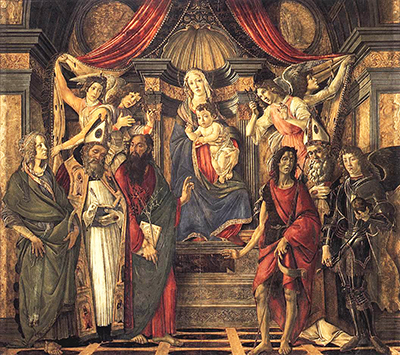Sandro Botticelli would sometimes produce religious paintings for local churches, normally in his native Florence. The item in front of us here is now in the Uffizi Gallery, but was originally designed for the San Barnaba Church in 1488.
The Madonna and Child sit patiently upon a throne at the very back of this depiction, with plenty of detail featured elsewhere. There is a whole plethora of different figures included here as well as some delightful touches of architecture at the very back. The church itself is fairly small in size and so perhaps that is why the artist chose to produce such a compact piece, in which all of the major figures are included, but without making this a huge mural-like piece that would have been too dominant within the interior of the church. Many of the figures have clues as to their identity, with certain elements being used by artists to signify the more significant figures from religious scripture.
Religion was the dominant theme within the full cycle of the Italian Renaissance and so the decision by Botticelli to focus on it so much was not at all unusual. What was unusual is in how he specifically covered the Madonna and Child scenario just so many times, with many appearing in the earlier part of his career. He would try out every possible variation on this theme that one might come up with, altering the background, rotating the positions of each figure, adding others in, and so on. He never seemed to lose interest or enthusiasm for this topic and perhaps enjoyed most the emotional connection between mother and child which Botticelli was just so good at delivering. He would of course go on to other challenges and Christ would appear in many different guises, often in relation to important moments of scripture which other artists would also have made use of within their own careers.
Botticelli left behind some highly significant innovations that would help the Early Renaissance to push forward and realise a number of important artists in the centuries that followed. By the 17th century there were a number of important painters in Spain, partly influenced by the achievements of their counterparts in Italy. One of those was Bartolomé Esteban Murillo who was a prolific and innovative painter who is best known by many for his work within the religious art genre. He left behind the likes of The Immaculate Conception of Los Venerables, The Immaculate Conception of El Escorial and The Vision of Saint Francis of Paola. Murillo was regarded as the finest artist of his time in Spain, but his popularity would fluctuate in the centuries that followed, just as was the case with Botticelli himself.




